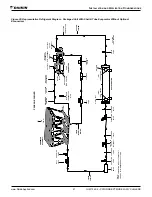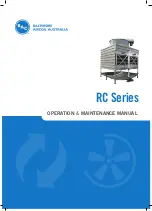
IOM 1242-2 • PATHFINDER
®
MODEL AWV CHILLERS
16 www.DaikinApplied.com
I
nsTallaTIon
and
a
pplICaTIon
C
onsIderaTIons
volume. Refer to Daikin Applied Chiller Application Guide, AG
31-003, for method of calculating “Minimum Chilled Water
Volume”.
The water quality provided by the owner/occupant/operator/
user to a chiller system should minimize corrosion, scale
buildup, erosion, and biological growth for optimum efficiency
of HVAC equipment without creating a hazard to operating
personnel or the environment. Strainers must be used to
protect the chiller systems from water-borne debris. Daikin will
not be responsible for any water-borne debris damage or water
side damage to the chiller heat exchangers due to improperly
treated water.
Water systems should be cleaned and flushed prior to chiller
installation. Water testing and treatment should be verified
during initial chiller installation/commissioning and maintained
on a continuous basis by water treatment professionals (see
Limited Product Warranty).
CAUTION
The improper use of detergents, chemicals, and additives
in the chiller system water may adversely affect chiller
performance and potentially lead to repair costs not covered
by warranty. Any decision to use these products is at the
discretion of the owner/occupant/operator/user as such they
assume full liability/responsibility for any damage that may
occur due to their use.
Flow Switch
A flow switch must be included in the chilled water system
to prove that there is adequate water flow to the evaporator
before the unit can start, or to shut down the unit if water flow
is interrupted.
A solid state, thermal dispersion flow switch that is factory-
mounted in the chiller leaving water nozzle and factory-wired is
available as an option. A field-installed version is also available
as an option.
Evaporator Freeze Protection
Evaporator freeze-up can be a concern in the application of
air-cooled water chillers in areas experiencing below freezing
temperatures. To protect against freeze-up, insulation and an
electric immersion heater are furnished with the evaporator.
This helps protect the evaporator down to -20°F (-29°C)
ambient air temperature. Although the evaporator is equipped
with freeze protection, it does not protect water piping external
to the unit or the evaporator itself if there is a power failure or
heater burnout, or if the chiller is unable to control the chilled
water pumps. Use one of the following recommendations for
additional protection:
• If the unit will not be operated during the winter, drain
evaporator and chilled water piping and flush with
glycol. Drain and vent connections are provided on the
evaporator for this purpose.
• Add a year-round glycol solution to the chilled water
system to provide freeze protection. Freeze point should
be approximately 10°F (5.6°C) below minimum design
ambient temperature or 10°F (5.6°C) below the lowest
design leaving water temperature, whichever is lower.
The use of glycol antifreeze is generally considered
the safest protection against freeze-up; however, it will
reduce the performance of the unit, depending on the
concentration. Take this into consideration during initial
system design and selection. On glycol applications, a
minimum fluid concentration should be based on Burst
Protection limits.
•
The field addition of thermostatically controlled heat
tracing and insulation to exposed piping, dependent on
power availability.
• Continuous circulation of water through the chilled water
piping and evaporator. (Dependent on power availability).
• The evaporator immersion heater is factory-wired to the
115-volt circuit in the control box. This power can be
supplied from a separate source, or it can be supplied
from the control circuit. Operation of the heater cable
is automatic through the fluid sensing thermostat that
energizes the evaporator heater cable for protection
against freeze-up. Unless the evaporator is drained in
the winter, the disconnect switch to the evaporator heater
must be closed. Conversely, do not apply heat to the
evaporator if it is drained.
Chilled Water Pump
It is important that the chilled water pumps be wired to, and
controlled by, the chiller’s microprocessor. The chiller controller
has the capability to selectively send the signal to a pump
relay (by others) to start pump A or B or automatically alternate
pump selection and also has standby operation capability.
The controller will energize the pump whenever at least one
circuit on the chiller is enabled to run, whether there is a
call for cooling or not. This helps ensure proper unit startup
sequence. To help prevent evaporator freeze-up, the pump
will also be turned on when the water temperature is equal to
or goes below the Freeze Set Point for at least three seconds.
Connection points are shown in the Field Wiring Diagrams on
page 19 and page 20
.
CAUTION
Adding glycol or draining the system is the recommended
method of freeze protection. If the chiller does not have
the ability to control the pumps and the water system is
not drained in temperatures below freezing, catastrophic
evaporator failure may occur.
Failure to allow pump control by the chiller may cause the
following problems:
1. If any device other than the chiller attempts to start the
chiller without first starting the pump, the chiller will lock
out on the No Flow alarm and require manual reset.
2. If the evaporator water temperature drops below the
“Freeze Set Point” the chiller will attempt to start the
water pumps to avoid evaporator freeze. If the chiller
does not have the ability to start the pumps, the chiller
will alarm
due to lack of water flow.
Summary of Contents for AWV008
Page 4: ......
















































